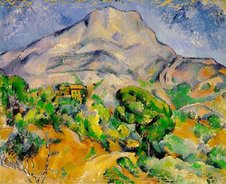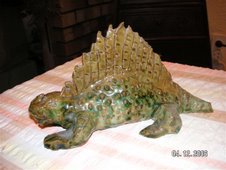Here's a quick tour of some pictures I took last March ( same day that I went on the London Eye, described in a previous post).
Here it is, somewhat hemmed in , but still expressing its sheer unexpected individuality. This is a building that would grace any city, but is especially right, I believe, for the City, given its pre-eminence as global centre for financial services.
Something exotic was needed, to signal that London is at home with the foreign and the exotic .
Does that amazing chequered spiral skin remind you of anything ? To me , there are multiple associations, so that although the shape is simple, the surface pattern is complex. I'm reminded not only of a glossy snake skin, but of a Fabergé egg at the same time. And see how well it looks

against a building from Christopher Wren's era. Who says old and new cannot go together ? The Parisians proved it was possible with their glass pyramid in the courtyard of the Louvre.
The next picture shows it as seen at street level. Just look at those glittering panes. Did you know that all the glazing, except for the dome at the very top, is flat glass, not curved as one might suppose ? Isn't that part of the secret of its appeal - a kind of flinty sparkle that would not have been achieved - at huge additional expense- with curved glass ?

The next picture shows that street-level criss-cross lattice work closer up. Some have criticized it as being too fussy, especially in the way the door is framed. Maybe: it's perhaps not the building's greatest feature. But again, it makes it like few, if any other, buildings, and is such a refreshing change from the slabs of polished granite, or stainless steel frontages, that tend to dominate the City.
In fact, if you go right up to the building and look up, the pattern of shapes - with tapering struts, lattice work, opaque and transparent surfaces, are almost like one of those three-dimensional works of art that one sees from time to time. Well, in France, anyway. For me, no part of this building offends the eye. Every aspect is a treat for the visual senses - a stunning yet harmonious juxtaposing of simplicity and complexity.

So far, I have unashamedly raved about this building. Nothing new in that, you might say. So what's this guy's real beef. There's bound to be a sting in the tail.
There certainly is. It's the building's name. It pains me even to mention it here: "The Gherkin". Or worse still " The Erotic Gherkin".
How did this magnificent work of art, comparable in my view, with the Taj Mahal, ever come to be lumbered with so vulgar a name ?

Until recently, I thought it was just some wag, saying the first thing that came to mind, and somehow, God knows how, it gained a wholly undeserved currency and got adopted.
Oh, one thing at a time. First I must mention some other more official names. The "Swiss Re Tower" is one of them. Swiss Re, as we know, is an insurance company that presently occupies most of the building. But supposing Swiss Re itself had an accident, whether by Act of God or otherwise, without having , heaven forbid, adequate insurance cover. What will they call it then ? The Swiss (RIP) Tower ?
There's another, even more official name: No. 30 St. Mary Axe. Well, that doesn't have quite the resonance of No.10 Downing St, does it ? And we don't call St.Paul's Cathedral No. 30 Paternoster Square or whatever. So let's return to that other, more "popular" tag, The Gherkin . How exactly did it come by that name ? As ever, Wikipedia comes to the rescue. But I was well and truly gobsmacked by what I read there, so here it is, verbatim .
"The plan was notable for its highly unorthodox floor plan, which resembled — some would argue — a slice of a pickle. The sub-editors at the Guardian newspaper coined the term, erotic gherkin for the building. Although Trafalgar House abandoned this plan, the nickname has stuck ."
So it's not the external cigar shape that is being referred to. (Just as well, since most gherkins have ridges, knobbles or both.) It's the shape of an original plan, viewed in cross-section (it would seem). Reading between the lines, the original floor plan , subsequently binned, would have been shaped rather like a cog wheel, with protruding rounded-teeth - in other words the way a ribbed gherkin might look in cross-section.
But as stressed that plan was binned, yet that mocking name, coined by a Guardian sub-editor, stuck. Why ? What kind of inertia, laziness, lack of imagination and downright disrespect for architectural genius has lumbered us with a name referring to something that never got beyond the drawing board?
It leaves this blogger with a sense of impotent fury and despair that our society can be so crass as to mis-christen this incredibly beautiful addition to our capital city. Especially one that has won so many awards: in December 2005, for example, the building was voted the most admired new building in the world, in a survey of the world's largest firms of architects.
In the interest of balance, , one should mention that in June 2006 , it was also nominated as one of the five ugliest buildings in London by viewers of BBC London News who placed it fourth out of the five choices they were given. Personally speaking, I set little store by anything the BBC does to "test" public opinion, but will spare you for now my views on the BBC.
So what should it be, or have been, called ? Realistically, it's probably now too late for second thoughts now. Names stick, even bad ones, like mud. And that's where Foster Partners/ Ken Shuttleworth have been somewhat remiss . Or maybe they were too trusting of our cynical, seen-it-all-before, UK media. An essential part of those architects' planning process, given their stratospheric international reputation, should have been to endow it at the very outset with a monicker that dignified it, especially given its sombre origins as a replacement for the bombed-out Baltic Exchange.
Is it too late, one wonders, to organize a national competition, say with a £10,000 prize, for best Mark 2 name ? Well, that should concentrate minds, don't you think ? I'm sure the City of London could find just 1% of someone's City annual bonus .
Here's my suggestion, for what it is worth. As said earlier, the building reminds me of a Fabergé egg, and the egg is one of the most simple, beautiful, extraordinary shapes in nature. I would like to call it The Egg, pure and simple. But I can hear the protests. It's too slim and pointy to be called an egg.
I've tried googling for collections of bird's eggs to see if there is just one example of a slim egg, but there are few images available ( good in a way, since one does not want to encourage the despicable collecting of eggs).

But I then had an idea. This building rose from the ashes of the Baltic exchange. Well, ruins, actually. In other words, it's a phoenix, which as everyone knows is an imaginary mythical bird. But has anyone ever seen, or depicted, a phoenix egg ? One doubts it. Who's to say it is not slim and somewhat elongated. Who's to say it is not possessed of sparkling, mosaic-patterned shell, reminiscent of snake skin ? Problem solved: call the Foster/Shuttleworth creation the "Phoenix Egg". Or simply "The Phoenix" or "The Egg", depending on context, depending on desired nuance.
Calling it the Phoenix would send a signal that London has an indomitable spirit. You can blitz us, you can bomb us, but we'll make good the damage: if it's too severe, as in the case of the Baltic Exchange, then we'll use the opportunity to put up something better than was there before.
And the egg, apart from its delightful smooth symmetry, without edges or corners, is synonomous with the idea of birth and regeneration.
Final word: one can hear the objections. Surely the egg forms no part of the life-cycle of the phoenix, given that the firebird is born directly from the flames of its predecessor.
True, but if one reads Wikipedia, there is still a role for a phoenix egg:
Ed. Dec 17th Once again, pictures (my own!) are disappearing off the site, being replaced with a blank space and small red cross. This means having to laboriously reload them. This is a problem that Blogger (Beta) is going to have to sort soon if it is to maintain credibility.









3 comments:
Those are some innovative ideas for a different name, Colin. And indeed if you go to the website for 30 St Mary Axe, you can see that the owners have specifically forbidden that the name 'Gherkin' ever be used in any promotional literature.
Which is denial, in a way. Because, and as you say, it's probably far too late to change the popular usage now.
That makes me wonder whether the Metropolitan and District Railway (eventually to become the London Underground) was thrilled at first to be called the Tube, all those years ago.
Never mind. I love the building, too.
And here was my own ode to the Gherkin.
- Roads
Thanks for the interest. I've just realized why there has been so little traffic from links and categories: I used "The Gherkin" as label, rather than simply Gherkin !
From a quick glance, your blog looks exceedingly well-written, with interesting comment, so I'll be adding it to my margin in the next day or two (if that's OK by you).
Sure, and happy to reciprocate, Colin.
Post a Comment